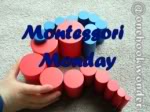Summer vacation. Time to relax, rest, rejuvenate... Well, perhaps in a perfect world that would be the case! Between
getting the floors refinished in the classroom,
familiarizing myself with a new computer, and keeping up with three kids at home, however, I can't say we've been relaxing around here... ;) Nevertheless, one of my favorite things to do (and believe it or not, it is relaxing for me) is to make materials for my classroom.
 |
| Can you guess what is happening here at my dining room table at home? |
One of the items on my to-do list is to make new record keeping booklets for
Sandpaper Letters. Please read more about them in
THIS POST if you are interested in understanding more about how these are utilized. I know this little project is something that has to be done at some point before school starts, so I went ahead and finished it - one less thing to do in those busy days right before school begins...
While making a new set for this Fall's students, I thought about how successful these record keeping booklets had been last year. They not only helped me in keeping track of each child's progress, but also became a meaningful source of motivation for my students and me. An exclamation could always be heard when a new letter was placed in a booklet - "Oh yay! I got a letter in my booklet!" or "I have so many letters in my booklet - I only have two more left to do! Let's do more Sandpaper Letters!" One can imagine the motivation these exclamations from my students provided me. As a result of the success with the
Sandpaper Letter booklets, I have decided to make a set dedicated to math lessons with the
Number Rods and
Sandpaper Numbers.
 |
| Math Booklet for tracking lessons with Number Rods and Sandpaper Numbers . |
Here, I will use the same principle as with the letter booklets - the first line of a triangle around a number will indicate introduction of a
Number Rod for a particular number, the second line of the triangle will indicate that the child is working on the
Number Rod, while the third line of the triangle will indicate mastery of the
Number Rod. One aspect which slightly differs with the math booklets is that the record keeping is for tracking two different materials - the
Number Rods and
Sandpaper Numbers. Therefore, once a child has a full triangle around a number, I will know they are ready for a corresponding
Sandpaper Number introduction. The introduction of the
Sandpaper Number will be marked with a small dot inside the triangle. When a child has mastered the
Sandpaper Number, the triangle in their booklet will be lightly shaded and the number recorded in their booklet. Also, if the child chooses, enough space can remain on each page to draw pictures which correspond with the number, i.e. eight stars to go with the number eight.
 |
| This shows that the child has mastered the Number Rod (triangle around the number), has been introduced to the Sandpaper Number (dot inside the triangle), and mastered the Sandpaper Number (shaded triangle). |
While it might seem a bit complicated, it works for me in the midst of lessons. I can easily see which numbers have been introduced, and which one the child is working on or mastered. Also, these booklets are a quick reference while inputting information in student
Montessori Compass reports.
I have a feeling these math booklets might generate just as much motivation for lessons with the
Number Rods and
Sandpaper Numbers as the letter booklets made for language
Sound Games and
Sandpaper Letters!





















































